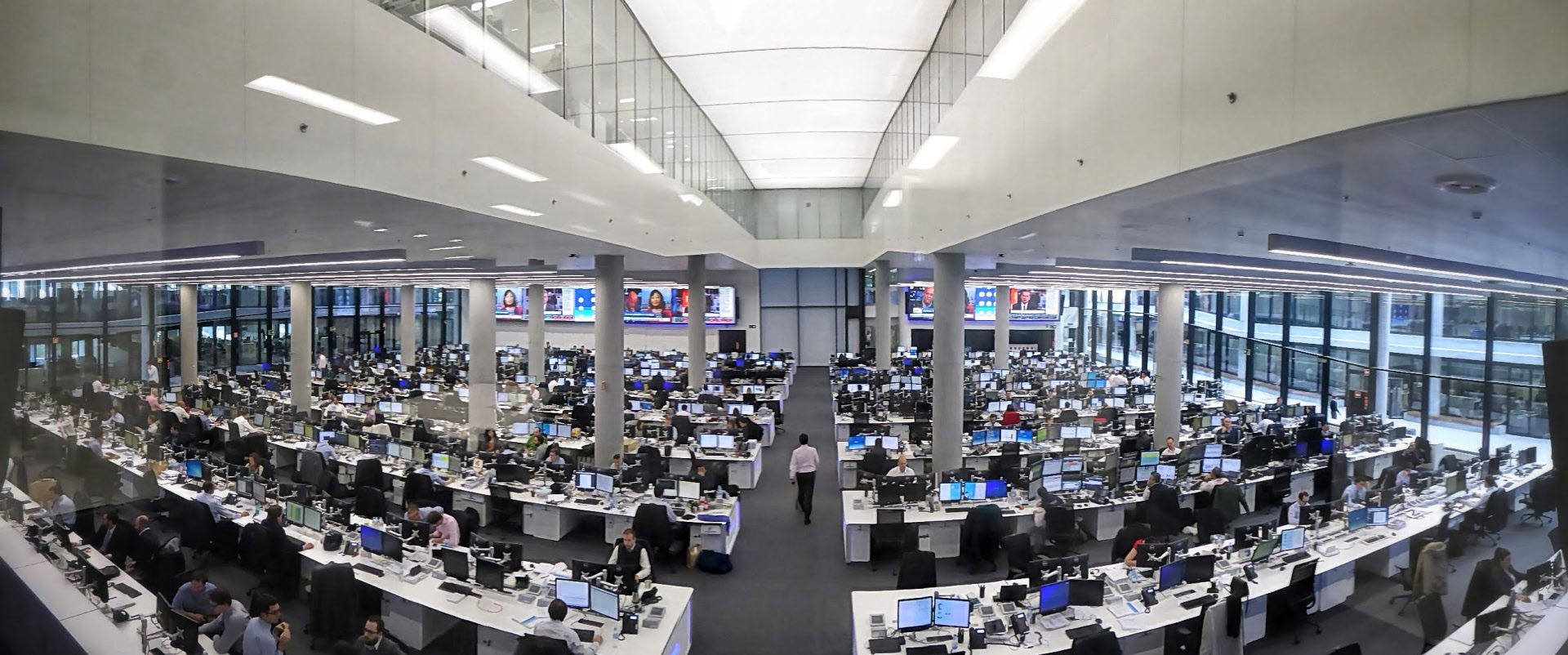The way trading rooms look has changed a great deal in recent years thanks to the introduction of new communications and computer systems, but the basic open-plan layout still dominates. Most of the desks traders use now have innovative cable management systems. Some even feature water or CO2 cooling technology, but they are usually still arranged in a traditional way.
This is because line of sight and instant communication is very important on a trading floor, and placing traders in cubicles or offices would increase the time they spend walking to and from each other’s work stations and reduce the amount of time they spend on the phone generating business. However, a number of recent studies suggest that the traditional open-plan approach may not be as productive as it was once believed to be.
History and Overview of Trading Floor Layouts
The open-plan layout that can be found in the vast majority of trading rooms dates back to 1906. That was when the Larkin Administration Building, which was designed by the legendary architect Frank Lloyd Wright, opened in Buffalo, NY. The concept caught on quickly because it promised to discourage idleness and improve productivity, a quality banks and other financial institutions value above all else for their trading operations. The many benefits of an open-plan office layout include:
- Easy and cheap construction: With no interior walls to worry about, open-plan offices are inexpensive and can be put together extremely quickly.
- Flexibility: Expanding an open-plan layout is as easy as wheeling in another desk and connecting a phone and computer.
- Maximize space: Little space is wasted in an open-plan office, which means that the number of traders working the phones can be maximized.
- Professional look: The reason most financial institutions include photographs of open-plan trading rooms with trading desk furniture in their brochures and other promotional materials is because the layout simply looks professional.
- More effective oversight: The financial sector is highly regulated, and the actions of a single rogue trader have been known to bring down banks worth billions. An open-plan layout makes it easier for managers and supervisors to see what is going on.
Considerations for Increasing Productivity
Getting the most out of traders is the key consideration when designing a trading room layout, and financial institutions are always on the lookout for new ways to tweak their trading floor layout to increase production. These efforts have led some experts to believe that pure open-plan layouts could actually be doing more harm than good. Issues that have been identified include:
- Group productivity: Researchers have long known that human beings are more productive and come up with better ideas when they work in small groups. Open-plan layouts may actually stifle creativity by suppressing individuals who would be more willing to speak up in a more intimate setting.
- Distractions: Trading rooms are boisterous environments, and traders may find it difficult to focus on the job at hand with everything that is going on around them. Studies suggest that it can take as long as 23 minutes for a worker to recover fully from a distraction.
- Noise: Traders are often loud and animated on the phone. When researchers from Cornell looked into the effects of workplace noise, they found that even relatively quiet sounds can increase stress and reduce motivation.
- Big Brother: Working in an open-plan setting can make workers feel like they are being constantly monitored. While this was once unavoidable in the finance sector because of its complex laws and regulations, advances in camera technology allow banks to take a more subtle approach.
Trading Room Design
If you are planning to open or renovate a trading room, you will be happy to know that the latest office furniture provides the benefits of an open-plan layout while still mitigating its negative aspects. Open plan desks are now available with small partitions that reduce noise and distractions. They also offer a modicum of privacy without blocking the clear line of sight of supervisors. What is a trading floor? Learn more here.
At Saraval Industries, we have been specializing in technical furniture for more than 25 years. We can help you to plan a trading room that will seamlessly integrate the creativity of your people with the capabilities of your technology. From desks to podiums to computer storage systems, we have a wide range of furniture solutions from leading manufacturers. Our specialists, IT experts and electricians will work with you from the initial planning phase until final implementation, and our support after the sale is second to none.
If you are interested in a free quote or would like to learn more, give us a call on (516) 768-9033 today.
